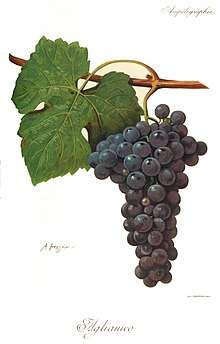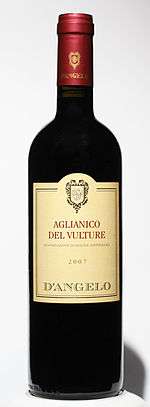Aglianico
Aglianico (English: /ælˈjænɪkoʊ/ al-YAN-i-koh,[1] Italian: [aʎˈʎaːniko]) is a black grape grown in the southern regions of Italy, mostly Basilicata and Campania. It is considered with Sangiovese and Nebbiolo to be one of the three greatest Italian varieties.[2] Aglianico is sometimes called "The Barolo of the South" (il Barolo del Sud) due to its ability to produce highly refined, complex fine wines like the famous Piedmont wine, Barolo.[3]
| Aglianico | |
|---|---|
| Grape (Vitis) | |
 Illustration of Aglianico grape | |
| Color of berry skin | Black |
| Species | Vitis vinifera |
| Also called | Gnanico, Agliatica, Ellenico, Ellanico, Uva Nera and "Southern Barolo" |
| Origin | Italy |
| Notable wines | Aglianico del Vulture, Taurasi |
| Hazards | Peronospora |
| VIVC number | 121 |
History
The origins of both the vine itself and its name are unclear. Traditionally, the vine is thought to have originated in Greece, first cultivated by Phocians from an unidentified ancestral vine; it was then brought to Cumae, near modern-day Pozzuoli, by Greek settlers in the 8th century BC, and from there it spread into southern Italy. However, modern DNA analysis of Aglianico does not support this view, revealing little relation to other Greek grape varieties. Its parentage also remains unknown, implying that it is likely to be endemic to its region.[2] If Aglianico was imported to Italy from Greece, no original Greek plantings have persisted.[4]
The name first appeared in print as the feminine plural Aglianiche in 1520, and several etymological theories persist.[2] The name may be a corruption of vitis hellenica (Latin for '"Greek vine"'), or of Apulianicum, the Latin name for the whole of southern Italy in the time of ancient Rome.[5] However, since there is also no record of the name Aglianico prior to the fifteenth century Spanish conquest of southern Italy, another possible origin of the name is from llano (Spanish for '"plain"') denoting a grape grown on the plains.[2]
Oenologist Denis Dubourdieu has said "Aglianico is probably the grape with the longest consumer history of all", claiming that Aglianico was used to make the Falernian wine famed during Roman times.[6] Along with the white grape Greco (today known as Greco di Tufo), the red grape of the region was regarded favourably by Pliny the Elder.[7] Traces of the vine have been found in Molise, Apulia, and also on the island of Procida near Naples, although it is no longer widely cultivated in those places.
Relationship to other grapes
Despite the similarities in naming, the Campanian wine grape Aglianicone is not a clonal mutation of Aglianico but DNA analysis does suggest a close genetic relationship between the two varieties.[3]
Wine regions
In Basilicata, Aglianico is the basis of the Aglianico del Vulture DOC and the region's only DOCG wine, Aglianico del Vulture Superiore, concentrated in the northern area of the province of Potenza. The most sought-after productions come from the vineyards located in and around the extinct volcano Mount Vulture.
In Campania, the area in and around the village of Taurasi in the Province of Avellino and the area around the Monte del Taburno in the Province of Benevento produce Aglianico wines bearing the DOCG designation. Taurasi was designated DOCG in 1993, and Aglianico del Taburno in 2011.[8] More Aglianico can be found in the province of Caserta, as the principal grape of Falerno del Massico.[9]

Other regions
The grape has also recently been planted in Australia and California, as it thrives in predominantly sunny climates with a long ripening season. In Australia it is being introduced in the Murray Darling region with some success.[10] Producers in McLaren Vale, Margaret River, Mudgee and Riverland are also experimenting with plantings.[4] Elsewhere in North America, it has been trialled in Texas and Arizona, and in Ontario, Canada.[11]
Viticulture
The Aglianico vine buds early and grows best in dry climates with generous amounts of sunshine. It has good resistance to outbreaks of oidium, but can be very susceptible to Peronospora. It also has low resistance to botrytis, but since it is much too tannic to make a worthwhile dessert wine, the presence of this noble rot in the vineyard is more of a viticultural hazard than an advantage.[5]
The grape has a tendency to ripen late, with harvests as late as November in some parts of southern Italy. If the grape is picked too early, or with excessive yields, the grape can be aggressively tannic. The vine seems to thrive in particularly volcanic soils.[12]
Wine styles

Wines produced from Aglianico tend to be full-bodied with firm tannins and high acidity, endowing them with good aging potential. The rich flavors of the wine make it appropriate for pairing with rich meats such as lamb. In Campania, the grape is sometimes blended with Cabernet Sauvignon and Merlot in the production of some Indicazione Geografica Tipica (IGT) wines.[13]
In its youth, Aglianico is very tannic and concentrated, requiring a few years of ageing before it can be approachable. As it ages, the fruit becomes more pronounced and the tannins more balanced with the rest of the wine. The trademark coloring of the wine is a deep garnet.[5] In well made examples of the wine, it can have chocolate and plum aromas.[12]
Synonyms
Aglianico is also known under the synonyms Aglianco di Puglia, Aglianica, Aglianica De Pontelatone, Aglianichella, Aglianichello, Aglianico Amaro, Aglianico Comune, Aglianico Crni, Aglianico del Vulture, Aglianico di Benevento, Aglianico di Castellaneta, Aglianico di Lapio, Aglianico di Taurasi, Aglianico Femminile, Aglianico Liscio, Aglianico Mascolino, Aglianico Nero, Aglianico Noir, Aglianico Pannarano, Aglianico Trignarulo, Aglianico Tringarulo, Aglianico Verase, Aglianico Zerpoluso, Aglianico Zerpuloso, Aglianicone, Aglianicuccia, Agliano, Agliantica, Agliatica, Agliatico, Agnanico, Agnanico di Castellaneta, Alianiko, Cascavoglia, Cassano, Cerasole, Ellanico, Ellenica, Ellenico, Fiano Rosso, Fresella, Gagliano, Gesualdo, Ghiandara, Ghianna, Ghiannara, Glianica, Gnanica, Gnanico, Granica, Granico, Hellanica, Malvasia, Olivella, Olivella di San Cosmo, Pie di Colombo, Prie Blanc, Ruopolo, Spriema, Tintora, Tintora di Cerinola, Tringarulo, Uva Aglianica, Uva Castellaneta, Uva dei Cani, Uva di Castellaneta, Uva Nera, Zuccherina.[14]
References
- "Aglianico". Oxford Dictionaries UK Dictionary. Oxford University Press. Retrieved August 18, 2018.
- D'Agata, Ian (2014). "Aglianico". Native Wine Grapes of Italy. University of California Press. pp. 162–167. ISBN 978-0-520-27226-2.
- J. Robinson, J. Harding and J. Vouillamoz Wine Grapes - A complete guide to 1,368 vine varieties, including their origins and flavours pg 13 Allen Lane 2012 ISBN 978-1-846-14446-2
- Clarke, Oz; Rand, Margaret (2001). "Aglianico". Oz Clarke's Encyclopedia of Grapes. Harcourt Books. p. 34. ISBN 0-15-100714-4.
- Robinson, Jancis (1986). Vines, Grapes & Wines. Mitchell Beazley. p. 213. ISBN 1-85732-999-6.
- Larner, Monica (7 January 2013). "The Rise of Italian Aglianico". Wine Enthusiast Magazine. Retrieved 9 October 2019.
- H. Johnson Vintage: The Story of Wine, p. 73 Simon and Schuster 1989 ISBN 0-671-68702-6.
- "Campania – DOCG Appellations & Main Rules". Flora's Table. Retrieved 9 October 2019.
- "Falerno del Massico Wine Region". Wine-Searcher. 18 August 2019. Retrieved 9 October 2019.
- Vinodiversity Aglianico accessdate = 2007-01-24
- "Vieni Estates - Wines - Red - Aglianico". www.vieni.ca. Archived from the original on 2017-08-25. Retrieved 2016-01-21.
- J. Robinson (ed) "The Oxford Companion to Wine" Third Edition pg 7 Oxford University Press 2006 ISBN 0-19-860990-6
- Oz Clarke Encyclopedia of Grapes pg 53 Harcourt Books 2001 ISBN 0-15-100714-4
- Aglianico, accessed on May 30, 2020